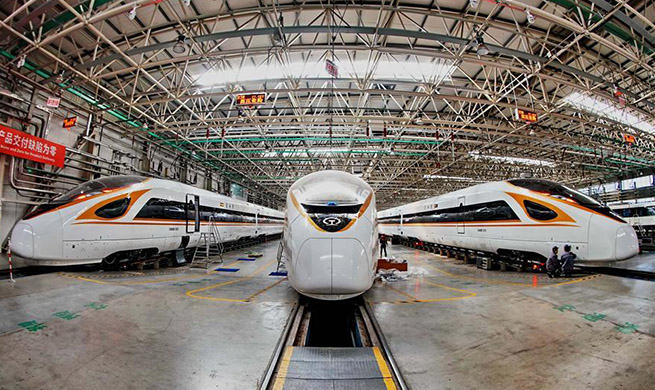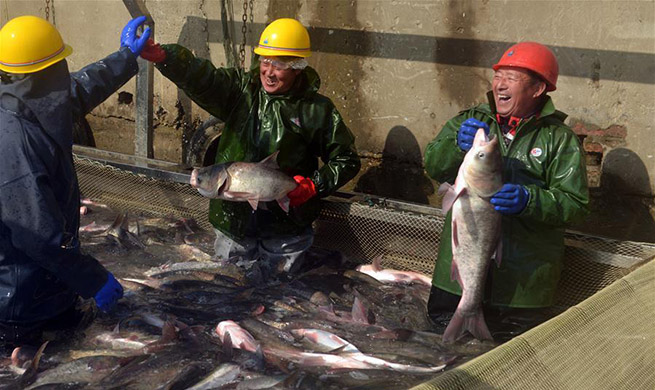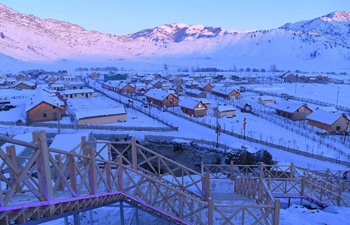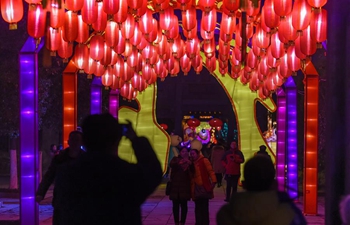Editor's Note: With preparations for the 2019 Lunar New Year in full swing across China, Xinhua will release a series of Spring Festival reports covering nationwide celebrations for the Year of the Pig and the annual travel rush (Chunyun), which will last until March 1.
BEIJING, Jan. 22 (Xinhua) -- Jin Yongxin stepped into the driver's compartment of high-speed train G4907 at a station in the coastal city Qingdao at 10:19 Monday before inputting vehicle data and checking the control panel.
Two minutes later, the train pulled out of the platform, marking Jin's last time serving in China's annual Spring Festival travel rush (Chunyun), which will last 40 days starting Monday.
The veteran driver will retire in 2019, after driving more than 2 million km accident-free in his 32-year career -- equivalent to driving around the equator 56 times.
However, this is no big deal for train drivers in China where the railway network has been expanding at an unprecedented pace for decades and the speed of trains has been raised for six times since the founding of the People's Republic of China (PRC) 70 years ago.
The 505-km Chengdu-Chongqing railway, operating in southwest China in 1952, was the first railway to be built after the PRC's founding.
Since then, railway construction has been relentless. At the end of 2018, the railways spanned some 131,000 km, from plateaus to plains, from deserts to cities. High-speed lines reached 29,000 km, accounting for two-thirds of the world's total.
Backed by the enormous network, a human migration of nearly 3 billion expected trips is gradually unfolding. Hundreds of millions of Chinese will return to their hometowns for family gatherings, to visit relatives and friends or just for a trip.
But things were different decades ago.
"Seventy years ago, China's railways were only slightly more than 20,000 km," Wang Junbiao with the China Academy of Railway Sciences said. "Around half of the total could not operate, and track gauges were different from region to region."
According to the calculation based on reports by the People's Daily, some 31 million trips were made in 1957, which seems trivial compared with the number this year, but it still put great pressure on the transport system.
The newspaper at that time even called on short-distance travelers not to use public transport but "take bicycles as much as possible."
The Spring Festival holiday is a frenetic travel period in China, but the means of transport have become much more efficient and convenient. The transport systems, including roads, railways and airlines, are well prepared for the surge in trips.
The fast paced development of railways, in particular high-speed tracks, has helped make China's entrepreneurial wave possible.
Yu Maosheng, 38, says the railway changed his life.
After years of hard work, Yu owns a dumpling restaurant in Shenzhen, a southern city at the forefront of China's reform and opening up and 2,000 km away from his hometown Linyi. He now earns 30 times that back in Linyi.
"But if there weren't any fast trains, I would give up my career in Shenzhen," Yu said.
Years ago when Yu was striving for a better life in Shenzhen, he found it painful to travel between the two places.
"I used to be stranded in line for several hours to buy tickets, and it took me more than 30 hours to return home by train," Yu said.
"Standing upright in the carriage crammed with passengers for the whole journey was pretty ordinary for me. Once, I never moved or lifted up my leg for a rest, because I knew there was not any chance for me to put it back if I did so," Yu said.
Thanks to the improving railway network and the launch of bullet trains, the trip between Shenzhen and Linyi has shrunk to 10 hours.
Today, Yu and his family go back to Linyi three or four times each year, traveling 16,000 kilometers in total. "It was unimaginable in the past," he said.
Wang believes China's steady technological advance played a vital role in building the railways.
"Chinese researchers have independently developed Fuxing high-speed trains running at 350 km per hour, and formed a set of technical standards for high-speed railway, plateau railways, heavy haul transport and railways in extreme cold areas," Wang said.
"Efforts are also being made in intelligent railways which will apply cutting-edge technologies including big data and artificial intelligence."
As a train driver who boasts vast experience in operating steam and diesel locomotives, as well as high-speed trains, Jin felt the technological progress more directly.
"Operating a steam locomotive fueled by coal was physically demanding, while my clothes would have a strong diesel smell after driving a diesel locomotive," Jin said. "Driving high-speed trains requires drivers to acquire more knowledge and skills, and we keep learning."
China has also developed the world's largest ticket service site, with nearly 3.5 billion tickets sold each year. New technologies and services such as face scan check-in, online meal reservations and WiFi services have also been applied at many train stations.
Yu bought round trip tickets in the Spring Festival travel rush for himself and his family on the website and is looking forward to trying the face scan check-in this year.
"I believe China's rail development will get better and better," he said.

















